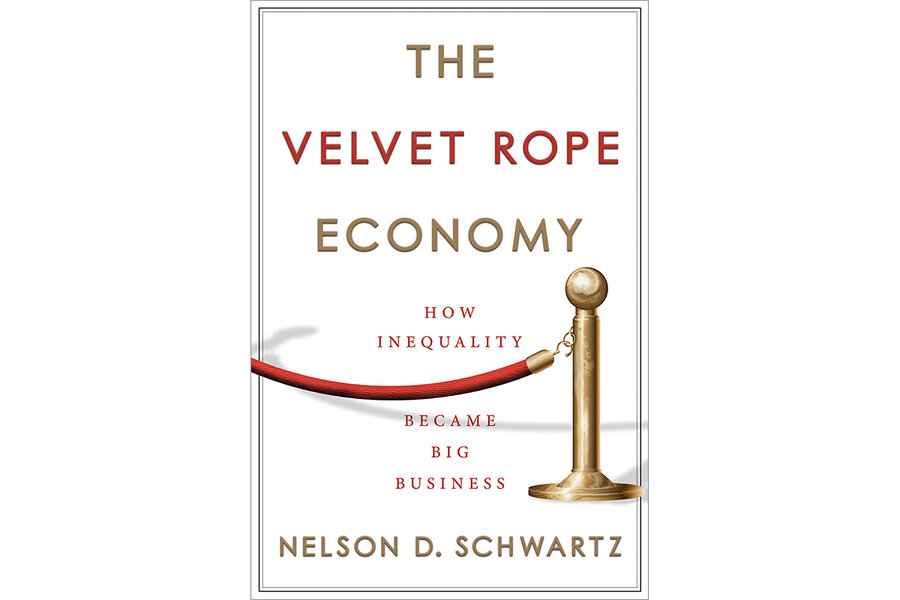The shadow economy that lets the ultra rich enjoy ‘friction free lives’
Loading...
“It’s tempting to think that when you call the bank or other another financial service provider and you are put on hold for twenty-five minutes, it’s simply because it’s a peak time of day and many other account holders are calling at the same moment,” Nelson D. Schwartz writes in “The Velvet Rope Economy: How Inequality Became Big Business.” That’s certainly what I had assumed before reading the business journalist’s eye-opening – and at times, outrage-inducing – nonfiction debut.
In truth, Schwartz explains, the order in which your call is taken is related to how valuable your business is to the institution you’re contacting. Companies use caller ID and databases to instantly determine your spending history and position you in the queue accordingly.
More and more areas of American life, the author argues, are segmented this way, characterized by “a Versailles-like world of pampering for a privileged few on one side of the velvet rope, a mad scramble for basic service for everyone else.”
The word “friction” appears throughout the book. Whether they’re breezing through airport security or easily securing an appointment with an in-demand medical specialist, the wealthy increasingly experience life as friction-free. “On the other side of the Velvet Rope,” Schwartz writes, “friction is practically the defining characteristic.”
Schwartz’s examples are wide-ranging. He describes stadiums that have separate entrances and dining rooms for elite ticket holders (New York’s Yankee Stadium even has a concrete barrier called “the moat,” which prevents anyone but the big spenders from getting close to the field); cruise vessels that have small, luxurious “ship-within-in-a-ship” areas accessible only to VIPs, who dine in their own private restaurants but have premium seats reserved for them if they opt to mix with the other passengers at a show; theme park packages that allow priority customers to bypass interminable lines; and concierge medical practices that spare their patients the hours others spend languishing in waiting rooms or the months they spend waiting to get appointments in the first place.
In the private sector, this escalating tiering of customers is driven by pure economics. As the gulf between rich and poor has become more vast, the richest 1% have gotten wealthier, with more cash to burn. Many businesses earn a disproportionate share of profits from their wealthiest customers, and they stand to expand their profits further by catering to the extremely wealthy with specialized products and services.
But Schwartz is particularly concerned with the extent to which a velvet rope is being erected in the public sector too. As public school budgets have tightened, students are increasingly charged “pay-to-play” fees to participate in sports, band, and other activities. Even pricier are club teams that cost families in the thousands each year. These days, college scouts typically only attend club team games – though football is an exception – diminishing the opportunities for student athletes from poor families to get athletic scholarships. In addition to “pay-to-play,” there’s “pay-to-stay”: Schwartz cites a number of California counties in which eligible convicts are offered the chance to serve their sentences by spending between $110 and $255 per night for spots in local jails, which are comfortable when compared with the county jails.
The author not only tells fascinating, readable stories, but he explains why they matter, especially now, when our politics and culture seem more polarized than ever. He bemoans the fact that there is less incentive for the wealthy to invest in public spaces when they increasingly have the ability to opt out of them entirely. For instance, he writes, “when corporate decision makers, members of Congress, and especially the political donor class routinely bypass traffic jams and deteriorating trains and buses and get to the airport via a luxury helicopter service ... the political impetus to improve public transit systems fades.”
Perhaps in a discouraging sign of how intractable these caste conditions have become, Schwartz is less effective when it comes to proffering solutions for the problems he so forcefully describes. He praises the highly profitable Southwest Airlines for its egalitarian treatment of customers. He also cites NYU’s medical school, which no longer charges tuition, and the publicly owned Green Bay Packers, whose games are more affordable and feature less tiered seating than most in the NFL. But these laudatory examples come off strictly as outliers, not as representatives of a growing trend. Reading this enthralling book is not a downer, but its inescapable implication – that we’re fast becoming an even more divided society with an irreparably frayed social fabric – sure is.






